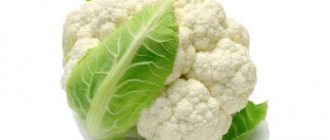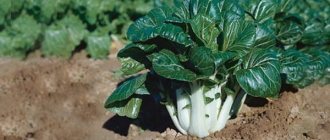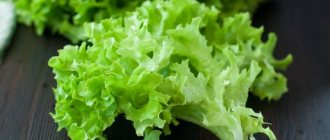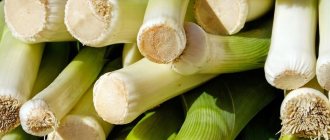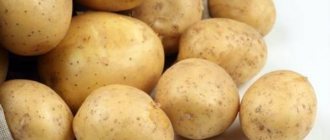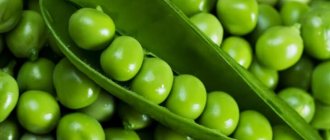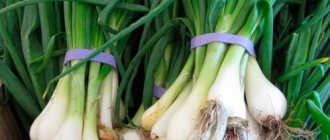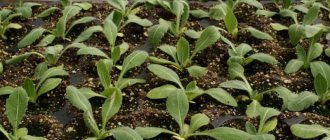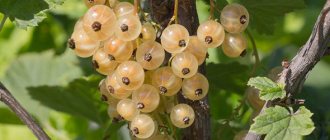Photo
In the photo you can see what it is - Brussels sprouts, what the vegetable looks like.
Botanical description
In botany, Brussels sprouts are classified as a biennial cross-pollinating plant, which is noticeably different in appearance from the classic type of cabbage.
In the first year, it grows a thick stem, reaching a height of 60 centimeters. Although this type of cabbage belongs to the cabbage family, it is not similar to any other species of this family. The leaf blades are green or grayish-green, with a slight waxy coating.
On the stem you can see small leaves on thin petioles; in the axils of these leaves inflorescences are formed - heads the size of a walnut. One inflorescence can grow from 20 to 40 heads of cabbage . In the second year of life, cabbage produces flowering shoots and the plant produces seeds.
The flowers themselves are yellow, sometimes with a white coating, they have raised petals. The fruit of Brussels sprouts is a multi-seeded pod, and the seeds are in the form of smooth black balls with a diameter of no more than 2 millimeters.
There are usually about 300 seeds in one gram. They can be used for planting for five years.
Description of culture
Brussels sprouts are a biennial garden vegetable. In the first year of its development, the crop grows rapidly, forms strong roots and produces a high yield. Next year, the stalk gives color and then forms pods filled with seeds. After collecting and drying, they can be used as planting material. The ability to peck seeds remains for 5-6 years.
The cabbage variety was bred artificially by Belgian vegetable growers in the mid-18th century. The basis was taken from a variety of kale. The culture is not found in the wild. The vegetable is endowed with a range of characteristic features: it stands out among other cruciferous crops.
- Brussels sprouts grow upright.
- The plant has a thickened trunk in the form of a cylinder. It reaches a height of 20-100 cm.
- The upper part is highly branched and has long petioles.
- The leaves are concave in shape, resembling a spoon. Length - up to 40 cm.
- The heads of cabbage are small in size with a diameter of 3-7 cm.
Externally, a head of Brussels sprouts resembles a white cabbage crop, but in a smaller form. Their formation occurs in the axils of leaves attached to short stems. One adult plant can produce a harvest of up to 20-90 heads. The weight of each of them reaches 8-20 grams.
Growing Brussels sprouts
First you need to treat the crops. Necessary actions:
- Soak dry seeds for a quarter of an hour in heated water (about +50)
- After this, rinse under running water and place in a solution saturated with beneficial microelements. Leave for 12 hours.
- Rinse again, wrap in a piece of gauze and place on the bottom shelf of the refrigerator for a day.
- After stratification, dry the planting material.
The seeds are ready for sowing. If a small amount is needed for work, then the rest of the material must be removed for storage in a hermetically sealed container. Preferably made of plastic or glass.
For seedlings
The seedling method is the most popular. This is explained by the long period of cultural development. The journey from planting material to harvesting the first harvest takes 120-180 days. Depending on the area where the vegetable grows, the number of days may increase. Northern areas may lack warm days.
In order for the plant to be strong, the following work should be done:
- Plant in a certain period: from March 16-18 to April 10-12.
- Prepare a container of sufficient volume so that the seedlings can develop comfortably. These can be peat pots, small cardboard containers, long wooden boxes.
- Treated seed material should be sown at a distance of 5-8 cm from each other. Planting depth is 1-2 cm.
- Temperature conditions are important for young seedlings. 3-4 days before the first shoots appear, the temperature is maintained at 18-20C, then it is reduced to 15-17C. This is necessary for hardening.
- Water the seedlings. It is important to ensure that the top soil layer does not dry out.
When the first leaves of seedlings form, you need to start picking. If the central root is long, it is shortened. It is at this moment that the young plant should be placed in a separate container for rooting and further planting in open ground.
Young seedlings need feeding. To do this, you need to dissolve special complex compounds in a bucket of water (10 l):
- Potassium sulfate −10-15 grams.
- Granulated superphosphate - 30-40 grams.
- Ammonium nitrate - 20 grams.
Popular: Proper use of ash as plant fertilizer
After 10-14 days, the fertilizer is applied again. This time the concentration of the mineral complex can be increased by 1.5 times. When the root system is fully formed, the young seedlings can be planted. Typically this period occurs at the end of May - beginning of June.
A couple of weeks before planting, the plants need to be hardened off. In the future, this will help protect young seedlings from death if the weather changes suddenly. For hardening, you can take the seedlings in boxes to an open veranda, balcony, loggia, or place them on a cool windowsill. Increase your time in the fresh air every day.
Transplanting seedlings into open ground
Brussels sprouts prefer to grow in brightly lit areas. It is desirable that the soil is fertile with a loamy type and a pH level of 6.5-7.5. The site for planting this vegetable crop is prepared in the fall. Digging the earth to a depth of 40-50 cm.
If necessary, powdered lime is used to alkalize the soil. In early spring, this area must be nourished with nutrients. Rotted humus with compost waste is suitable for this. Calculation: 1 meter2 will require 10 liters of liquid solution.
From bulk mineral mixtures use:
- Superphosphate.
- Wood ash.
- Urea.
It is not recommended to plant Brussels sprouts in a place where cruciferous crops have been grown over the past 2-3 years. This can be done no earlier than four years.
Plants belonging to the same family suffer from the same diseases, so there is a risk of infection. For example, these are white cabbage, turnips, daikon, radishes, turnips. The following crops are considered the best predecessors:
- Beans.
- Carrot.
- Cucumbers.
- Feather and onions.
Before planting in open ground, seedlings stop watering for one week. Watering on the day of planting.
Step-by-step algorithm for planting Brussels sprouts seedlings:
- Prepare the wells. Each size is 60x60 cm.
- Add a soil mixture to the bottom, consisting of rotted peat and turf layer, wood ash and a mineral complex.
- Sprinkle a little soil and place a young seedling in the middle. Try not to damage the young roots.
- Water, wait until the water is completely absorbed and sprinkle with soil on top. Lightly compact. The sheets should not touch the ground.
- Water again.
All manipulations should be done in the afternoon, when ultraviolet rays are not too active. You can also plant in cloudy weather.
Non-seedling planting method
If the climate is suitable, then early ripening varieties can be grown on the site. Seeds are sown in open ground at the end of April. At this time, the soil is sufficiently warmed by the sun's rays. Planting material is sown in one hole, 3-5 pieces, sprinkled with loose soil on top.
As soon as the seedlings grow a little, they are thinned out. The strongest specimens are left in the hole. After two weeks, the seedlings should be thinned out again. One seedling remains in the hole, which looks the most viable. Next, the cruciferous crop is cared for in the usual way.
How to water and care for Brussels sprouts
Brussels sprouts do not require much care, but they still have some differences. The vegetable does not tolerate hilling. In other matters, care is no different from other cabbage species. A week after planting, the seedlings need to be fed with fertilizer.
- First feeding. Dust the bed with nitroammophoska. 0.5 teaspoon is enough for one well. Additionally, water with a solution containing diluted organic matter or a mineral complex. After two weeks you can repeat.
- Secondary serious feeding is carried out when heads of cabbage are formed. To prepare the solution in a bucket of water (10 liters), you will need 5 grams.
Popular: All the benefits of mulching the soil for high yields
Cruciferous crops require moisture, so the soil where Brussels sprouts are grown should always be slightly moist. With a single irrigation, the water consumption is 350 liters for an area measuring 102 meters. When the first ovaries appear, the rate of water consumption is increased to 400-450 liters.
The soil under cabbage sometimes needs to be loosened and weeds removed. Loosening is also carried out after rains or regular watering. If this procedure is rarely done, then due to a lack of oxygen, the cabbage roots will begin to die, which will lead to the death of the mature plant.
Before harvesting (about 2-3 weeks), decapitation is carried out. It is necessary to remove the tops of each bush. As well as rosette foliage. Thanks to such manipulations, the growth of heads of cabbage is activated.
Brief history of origin
The mystery of the appearance of this mysterious type of cabbage is still considered unresolved. Some sources say that Brussels sprouts were developed from kale by vegetable growers. Collard greens, as you might guess from the name, were first grown in Brussels. And already in the middle of the 18th century, the name and classification of this vegetable was given by the famous scientist Carl Linnaeus .
He was the first to give its scientific description, and named it in honor of Belgian gardeners.
Cabbage appeared in Russia in the mid-19th century , but it was not possible to spread it in our latitudes due to weather conditions. Now it is cultivated in the UK, USA and Canada.
Brussels sprouts growing from seeds when to plant
Brussels sprouts cultivation and care in open ground
The longest ripening cabbage is Brussels sprouts. Growing seedlings from seeds is the only way to get results in our weather conditions.
- You can sow at the end of March , as soon as the soil is ripe, cabbage is not afraid of frost and survives cold weather well, frosts down to -3°C.
- A depth of 1 cm is enough, the distance between the rows is 10-12 cm.
- Water generously and cover with film. Shoots appear in about 7-10 days.
- It is important to protect the seeds by treating them against the cruciferous flea beetle or sprinkling the preparation directly into the rows.
- Further care is absolutely simple: water once a week and weed the weeds.
- As soon as the seedlings have risen a little, break through the dense crops, leaving 1 plant per 5 cm.
Brussels sprouts are sown in rows for seedlings
When the plant height is 10-15 cm, they are planted in holes in a permanent place. Before planting, it is advisable to spill the holes with water and add a couple of pieces of loose humus.
Varieties
How to choose the right variety?
When choosing varieties of cabbage called “Brussels sprouts,” it is important to consider three main characteristics:
Late ripening of the crop . The earliest ripening varieties of cabbage do not ripen before 130 days. The closer to the east of the country the growing zone is, the more reasons there are to plant early-ripening varieties.
- Productivity . If the most common variety “Hercules” produces an average of up to 40 heads of cabbage, then new hybrids can boast of a quantitative increase in yield by half and a larger fruit size.
- Content of useful substances . Russian varieties come without changing the qualitative composition of cabbage. Hybrids of foreign selection are bred with a high content of protein, carotene and mineral salts.
Most Popular
- "Isabel".
- "Long Island.
- "Rosella."
- "Rudnef".
- "Franklin F1".
- "Dolmik F 1".
Cleaning and storage
The first heads of cabbage appear on the plant approximately 3-3.5 months after planting the seedlings in the beds, but it is better to postpone harvesting until the onset of cold weather. Low temperatures do not in any way affect the microelement composition of cabbage, but, on the contrary, improve the taste.
A couple of weeks before harvesting, you need to cut off all the top leaves. This way all the juice will flow directly into the heads of cabbage. The lower fruits need to be removed first and it is advisable to do this at a temperature of -6 or even -10 degrees.
The timing of harvest depends on the conditions and duration of storage of cabbage:
- If you plan to store the heads of cabbage for a long time, then the plant must be removed from the garden along with the rhizome. Cabbage is buried in a box with soil and stored in a cool room.
- The heads of cabbage can be trimmed and placed in a plastic bag and stored in the freezer or refrigerator for 1.5-2 months.
- To store the crop indoors, you need to cut the stem above the ground, remove the leaves and top. Then the stem is dried and stored.
Comparison with cauliflower and broccoli
Of course, when choosing cabbage you need to focus on taste preferences . But the question arises, which vegetable is the healthiest? And which one is suitable, for example, for the first feeding.
Of course, broccoli is the leader in terms of the amount of nutrients. It contains carotene and a huge amount of plant proteins. This cabbage is the most dietary, it blocks the formation of cholesterol, which means it is suitable for anyone losing weight. Cauliflower also contains a lot of proteins and vitamins; it is digested very quickly, but is not suitable for people with urolithiasis.
But the leader in terms of usefulness and digestibility by the body will be Brussels sprouts . It contains three times more vegetable protein than cabbage. With all this, it contains a huge amount of vitamin C! Cabbage is suitable for both children and adults.
It has a beneficial effect on the functioning of the gastrointestinal tract.
Diseases, pests
Although this type of cabbage crop is distinguished by its unpretentiousness and stability, it still does not tolerate neglectful attitude. Due to insufficient care, there is a risk of developing diseases. Also, at any stage of development, the crop can be affected by flying harmful insects. Therefore, you need to regularly inspect the plants.
The main signs of Brussels sprouts being damaged by diseases or pests:
- Fusarium. The fungal disease mainly affects the foliage and stem parts of the plant. Cabbage has a contrasting color change. Green varieties become golden, burgundy varieties become gray-brown. The plant is withering.
- Powdery mildew. Cabbage leaves are covered with a thin white coating. This usually occurs due to excess air humidity.
- Viral or bacterial infection. Most often, the disease affects a weak adult plant or young seedlings. The tops show vascular patterns including specks of black and yellow.
- Cabbage clubroot. Of all diseases, this is the most dangerous. It affects many species of plants belonging to the cruciferous family. In this case, the root system is deformed, as a result of which the crop begins to dry out. The growth and ripening of heads of cabbage stops.
- Scoop. The larvae of cabbage, garden or winter butterflies adore the pulp of the stems. Sometimes they can gnaw through it from the inside.
- Medvedka. The larvae or adults of this insect dig numerous tunnels in the surface layer of soil. As they move along, they simultaneously eat the young roots of the plant.
- Aphid. Cabbage leaves may be covered with small midges. From the outside, these gray-green islands resemble mold.
- Cabbage fly. It is the larvae of this insect that are dangerous to the plant. The adult lays eggs under Brussels sprout bushes. During their development, the larvae begin to feed on green tops.
- Fleas (earthen). If you notice many tiny tiny holes that turn the foliage into a sieve, it means there are earthen fleas. Insects attack only young plants; the rough peel of mature cabbage cannot be overcome by jumping insects.
- Cabbage butterfly. If you turn the leaf over, you can see eggs laid in groups underneath. This is the offspring of the cabbage butterfly. When the larvae hatch, they move onto the foliage and eat it.
If you take preventive measures to prevent the formation of diseases and attacks of harmful insects, then Brussels sprouts can be saved.
Preventive action:
- Before planting, it is imperative to disinfect the seeds.
- Monitor the acid-base norm of the soil composition. Pathogenic flora develops faster in an acidic environment.
- After watering and rain, loosen the soil. Promptly remove weeds from the garden plot.
- Take neighboring crops into account when planting.
- In the fall, after harvesting, plow the soil.
Popular: Fast and maximum yield of tomatoes by pinching
If detected, it is recommended to use non-toxic products:
- Naphthalene, Proteus, wood ash - destroy butterflies and larvae
- Herbal infusions of thyme, chamomile, and ash are used to treat the plant against aphids.
- Wormwood decoction, powdered boric acid will save you from the invasion of earthen fleas
- Fundazol, Trichodermin, baking soda - against fungal diseases
- Medvedtox, kerosene or soapy water, oil will help drive mole crickets out of the garden.
Leaves damaged by disease or pests should be removed. If the entire bush is affected, then it is completely uprooted. If Brussels sprouts have been affected by clubroot or viral diseases, then it is not recommended to plant cruciferous crops in this area for several years.
How is it useful?
Eating this variety strengthens blood vessels and protects the heart.
This is an excellent prevention of cardiovascular diseases. It is also useful:
- For the respiratory system.
- For the prevention of tumors.
- For metabolism.
- For normal bowel function.
- For normal functioning of the nervous system.
- To restore strength.
- Has beneficial properties for the immune system.
Video about the benefits of Brussels sprouts:
Read more about the benefits and harms of this vegetable in another material.
Application of the vegetable
Brussels sprouts in our country are still a gourmet dish, but there is hope that they will become more widespread in our country.
Eating
The calorie content of Brussels sprouts is only 43 kcal per 100 g.
Recent Entries
5 working ways to use tar in the garden 7 indoor plants that help you get married even in adulthood Indoor plants that can bloom in trouble
Dietary cabbages make excellent first and second courses:
- light soups,
- vegetable stew,
- tender casseroles.
For long-term storage, they are first blanched and frozen. And the healthiest way of cooking is steaming.
The healthiest cooking method is steaming.
In England, Brussels sprouts are traditionally served at Christmas as a side dish for the Christmas goose.
Video: how to cook Brussels sprouts with mushrooms
In folk medicine
The juice of the plant in combination with the juices of other vegetables is used to treat respiratory diseases. They are also used for diabetes.
Nuances of use for gastrointestinal diseases
For gastritis
Small heads of Brussels sprouts contain ballast substances, and they stabilize and normalize intestinal function.
Cabbage perfectly and quickly removes all toxins from the body . Therefore, for gastritis, this vegetable is simply irreplaceable.
For pancreatitis
But for acute pancreatitis, it is better to avoid Brussels sprouts. Its main disadvantage for patients with pancreatitis is the presence of a large amount of fiber, which, on the one hand, helps get rid of cholesterol and toxins and effectively copes with intestinal obstruction. On the other hand, it provokes increased gas formation and irritation of the digestive tract.
Can children eat it?
Brussels sprouts are indicated for children, especially those who have a lack of iron and problems with stool.
It is recommended to use complementary foods when the child reaches six months. You can use cabbage as a puree or add a little boiled cabbage.
We talked about all the recommendations for consuming vegetables for children and during breastfeeding here.
Step-by-step instructions for growing
Brussels sprouts should be planted at an average daily temperature of no higher than 18-20°C.
- Dry the seeds.
- Plant in separate pots with a mixture of turf soil, peat and sand.
- The first two weeks do not water the seedlings.
- After two weeks, water the seedlings along with a lump of earth.
- Brussels sprouts seedlings are fed twice.
- Preparations for landing begin two weeks in advance.
- To plant Brussels sprouts in the ground, it is better to choose a cloudy day.
- The cabbage is placed according to a 60x60 cm pattern, with the holes being slightly larger than the seedling pot.
Watch a video about how to properly grow Brussels sprouts:
How to plant Brussels sprouts?
Brussels sprouts can be grown in two ways - seedlings or sowing seeds in open ground. Each method has its pros and cons; you have to choose a planting option taking into account the climatic characteristics of the region and your own preferences.
Seeds
Sowing seeds in open ground is used less often than the seedling method. It is beneficial for mass cultivation, as it allows you to avoid two stages at once - picking and transplanting into open ground. But with this method, the harvest comes later.
The seeds are sown quite early - in March-April. Focus on the soil temperature - it should warm up to +10-15°C. The order of sowing in open ground:
- Make shallow rows or holes in the prepared beds for nesting planting. Planting depth is no more than 1.2 cm. The distance between adjacent seeds is 15 cm.
- Cover the crops with film so that the seeds begin to develop faster.
- When the seeds sprout, thin them out, choosing the strongest sprout. Pull out the rest so that the cabbage has room to develop. There should be 50 cm between neighboring plants.
Early and mid-season varieties are sown in open ground, with a growing season of no more than 120 days.
Seedlings
Any type of cabbage does not tolerate transplantation well, and Brussels sprouts are no exception. Therefore, seedlings are grown in separate glasses - so that when planting in the ground, simply transfer a clod of earth with roots into the prepared hole - this reduces stress for the plant.
To grow seedlings, special cassettes or glasses are used. The volume of the container for one seedling is 200 ml. The procedure for growing seedlings:
- Fill any selected container - cassettes, glasses or seedling boxes with substrate. If using boxes, make grooves in the soil for the seeds. The depth of the rows or holes is 1 cm.
- Water the soil with warm water.
- Sow the seeds, spacing them 0.5-1 cm apart.
- Sprinkle the seeds with soil and compact it gently.
- Cover the crops with transparent material - glass or film.
- Place the containers with the crops in a warm place to get seedlings faster.
- After germination, remove the film or glass. Move the seedlings closer to the light. The optimal daytime temperature is +20°C, night temperature is not lower than +16-18°C. This temperature regime will not allow the seedlings to stretch beyond measure.
- Care for seedlings according to the following plan:
- Water as the soil dries out. Watering Brussels sprouts too frequently is contraindicated. Check the humidity at a depth of 1-1.5 cm. It is advisable to water the seedlings through a strainer so that the soil does not erode.
- To prevent blackleg, water the seedlings with “Fitosporin” or a pink solution of potassium permanganate. You can also sprinkle the soil with wood ash, with colloidal sulfur previously added to it.
- If you sowed the seeds in common containers, and not in individual glasses, there is one more step ahead - picking. Its essence is seating in separate containers. Pick up the seedlings after the first true leaves appear. You will need a small peg - use it to remove the grown seedlings - take them out along with a lump of earth and pinch the root. Bury the seedlings down to the first true leaves - if you plant the seedlings deeper, the stems may rot.
- Water the picked seedlings well and place them in the shade. The optimal air temperature is 20°C. When the seedlings begin to grow, expose them to light. But it should be cool here - no more than +16-18°C. Such conditions contribute to the formation of a strong root system.
- When the daytime temperature reaches +10°C, start hardening the seedlings for 5-10 minutes, take the seedlings out at midday. When the seedlings get used to the sun, it will be possible to take it out in the morning and keep it there until 16-17 hours.
It is impossible to overexpose seedlings - seedlings that are too large take root worse, grow more slowly and produce smaller yields. Seedlings are planted when they have 3 or 4 true leaves. Seedlings should be completely healthy and dark green in color.
After 2-3 true leaves appear, feed the seedlings with Kemira-Lux solution (1-2 g dissolved in 1 liter of water). Be careful not to get any liquid on the leaves. Feed the seedlings a second time 1.5-2 weeks before planting in open ground - add a solution of boric acid and copper sulfate (take both on the tip of a knife for 10 liters of water).
The procedure for planting seedlings in open ground:
- Stop watering the seedlings in 4-5 days.
- When the soil warms up to +10°C, the seedlings are planted in the prepared holes. Plant according to the pattern 60x40-50 cm (between rows - 60 cm, between plants - 40-50 cm).
- Transplant the seedlings into the holes using the transshipment method - remove the roots along with a lump of earth.
- Place the seedling in the holes so that the roots are comfortably located in it. The depth of the hole should be slightly greater than the length of the roots. It is better for the stems to be somewhat buried rather than for the roots to be on the surface.
- Compact the soil thoroughly so that there is no air left between the roots.
- Water the seedlings thoroughly.
We invite you to watch a video story from a gardener about how she grew Brussels sprouts using seedlings:
Diseases and pests
Brussels sprouts are attacked by insects such as cruciferous flea beetle, cabbage fly, mole cricket, and wavy flea beetle. Aphids, moths and cabbage bugs are especially dangerous. To avoid the plant rotting and being eaten by insects, it is advisable to acquire special means.
- Brussels sprouts most often suffer from diseases such as clubroot, white and dry rot, black leg, ring spot, downy mildew, vascular and mucous bacteriosis.
If pests attack, use insecticides , and if signs of fungal diseases appear, treat the plantings with fungicides. The plant must be given first aid immediately, otherwise the entire harvest may be lost.
Features of growing Brussels sprouts, harvesting and storing them:
- advanced gardeners, especially in areas with constant winds, install supports to prevent vegetables from falling over
- if the leaves framing the place where the stalks are attached begin to turn yellowish, and the fruits themselves become covered with a pronounced waxy coating, you can celebrate victory; it’s time to harvest.
- the harvest is harvested selectively, starting with the largest lower heads, ensuring further growth and nutrition of the upper heads
- Do not delay harvesting too much, wait for the heads of cabbage to become too large - the resulting bitterness will reduce the pleasure of the taste
- at the end of the season, the apical leaves are removed and the stems of Brussels sprouts are cut down. They can be stored without picking the heads, wrapped in plastic wrap at a temperature close to 1 C for another couple of months.
- Plants dug up along with their roots can be transplanted into a greenhouse for growing in the fall, because successfully grow at low temperatures. In this way it is easy to extend the fruiting period and get healthy cabbage for several more weeks.
We invite you to learn the tricks and secrets of growing Brussels sprouts from the video review:
Cooking the vegetable
Diet soups and classic cabbage soup without meat
These soups are prepared based on vegetables.
- To do this, you need to boil some of the vegetables and sauté some. Sautéed together: carrots, onions, tomatoes, Brussels sprouts.
- The remaining vegetables - cabbage, potatoes - are boiled in a separate pan.
- If you want to cook cabbage soup, add regular cabbage to the recipe. It needs to be chopped into strips and boiled until softened.
- Sour cream and fresh herbs also go well with cabbage soup.
Watch the video recipe for Brussels sprouts and pepper soup:
A couple of quick recipes
Take the prepared cabbage and add it to the hot meat broth.
- Add pre-boiled carrots and potatoes, pour in a little tomato paste.
- 15 minutes after boiling again, stir thoroughly and cook for 15 minutes over low heat.
Another recipe:
- Stew the cabbage in a frying pan with salt, pepper and tomato paste.
- Then cook chicken broth, add cabbage and dry vegetable mixture, salt and pepper, add herbs.
Cabbage stewed in broth:
- First, fry the garlic and carrots, add a spoonful of cream and a spoonful of tomato paste, pepper, salt, and add heads of cabbage.
- Simmer for 15 minutes.
- Add potatoes and regular shredded cabbage to boiling water and cook for seven minutes.
- Then pour the mixture from the pan.
- Add salt and cook for another 10 minutes.
- You can add rice or other grains to the soup to taste.
Another quick recipe for delicious Brussels sprouts:
You will find the main characteristics and recipes for cooking Brussels sprouts in another article.
Tips for proper care
The harvest of Brussels sprouts depends on proper care.
The most important activities are: treatment of row spacing - destruction of weeds, loosening the soil, maintaining the air-water regime. After the trunk is fully formed, you need to pinch the last bud to improve stimulation of fruit ripening. Since Brussels sprouts grow for a long time, and the distance between the seedlings is quite large, it is allowed to plant some early crops between them: tomatoes, cucumbers.
Watering and fertilizing cabbage
The plant is moisture-loving and requires regular watering. During growth and fruiting, it is watered 10 or more times. In this case, it is advisable to water deeply, pouring up to 8 liters of water per 1 square meter. m, and during the period of fruit formation up to 10-12 liters. In rainy weather, the frequency of watering and the amount of water used must be adjusted. Cabbage is watered in 3 ways: sprinkling, furrow and drip.
After 2 weeks from the moment of planting, the formation of a rosette of leaves begins, and the time comes to increase nitrogen nutrition. The first fertilizing is carried out. It depends on how well the beds were fertilized in the fall. If all norms for applying organic fertilizers are met, then the first fertilizing can be limited to the application of nitrogen-containing mixtures; after the appearance of the first ovaries, fertilizing with potassium salt can be carried out. Organic fertilizer diluted in water is also used: mullein 1:6, bird droppings 1:10, slurry 1:4 for up to 1.5 liters of solution per plant.
The fertilizing process must be approached with caution - an excess of fertilizer can affect the quality of the heads of cabbage, they will be loose, a lack of nitrogen will appear on the green mass - the lower leaves will begin to turn yellow and fall off.
Hilling up and loosening the soil
Considering the peculiarity of the structure of Brussels sprouts - the largest heads are formed in the axils of the lower leaves, hilling is not carried out or is carried out in a small layer. During the growth, development and maturation of plants, up to 6 or more loosenings are carried out, always after watering or precipitation.
Delaying loosening will retard their growth. The first is carried out on the 3rd day after planting the seedlings. The main thing is not to forget to mulch the bed.
Pre-harvest care
A week before the expected harvest, the leaves are removed from the plant. So, from plants that ripen at the same time, they are removed at once, trying not to disturb the integrity of the heads. And with gradual ripening - in 2-3 steps, leaves are removed only from the intended harvest area.
Collection and storage
Harvesting begins after the fruits reach maturity. It is distinguished by its maximum size, the special shine of the head, and the yellowed leaf at the base. Early-medium varieties ripen in September-October. Brussels sprouts of these varieties are harvested in 2-3 stages. Starting from the bottom, place them in containers and place them in a cool place. At a storage temperature of 0 C they do not lose quality for up to 1.5 months, when frozen all winter.
Mid-late varieties that ripen at the same time are ready for one-time harvesting in October-November. When harvesting this type, it is possible to cut down the stems near the ground, store them in heaps, and then separate the leaves and fruits.
Brussels sprouts can be stored fresh during the winter and consumed as needed. To do this, plants are dug up before the first frost and buried in sand in an inclined position in a basement or greenhouse.
If these conditions are not available, you can store them in the refrigerator by packing the stems with fruits in plastic bags.
Why might it be bitter and what can you do about it?
The only thing that scares all cabbage lovers away from Brussels sprouts is the bitter taste.
This property can spoil any dish and cause rejection of the product not only in children, but also in adults. But you can get rid of unpleasant bitterness .
Usually cabbage that is not young, but has already “rested”, is bitter. But even an old vegetable can have a better taste. To do this you need:
- Add basil, marjoram or other Provençal herbs to the dish.
- It is also recommended to add garlic when baking.
- Well, the simplest but most effective way is to add salt, a pinch of sugar, and one teaspoon of vinegar when cooking. All this is taken into account per liter of water.
- You can also neutralize bitterness with lemon juice by adding a small amount to the prepared dish.
Mid-season varieties and hybrids
Funny company
Brussels sprouts variety Cheerful Company
The bright variety ripens 160–170 days after the appearance of full-fledged shoots. The stems are of medium height and require staking. The heads are small, rounded-elongated, greenish-purple in color, weighing 10–12 g, densely located in the axils of the leaves, up to 60 forks are formed on one plant. Total weight – about 0.6 kg. The internal structure is moderately dense, the taste is good.
The variety has an attractive appearance, excellent yield, is suitable for preparing a variety of dishes and marinades, and retains its properties well when frozen. Harvests reach 24 kg per 10 square meters. m.
Garnet bracelet F1
Brussels sprouts variety Pomegranate bracelet F1
A productive, stable hybrid is characterized by colorful purple heads of cabbage, suitable for harvesting 120–125 days after planting the seedlings. Purple-violet vesicular leaves are slightly waxy, without wavy, densely planted on short petioles. The heads are round, thick purple in color, formed on one stem in 30–40 pieces, with a total weight of 0.4–0.5 kg.
Unpretentious plants can withstand frosts and form stable yields of up to 15–20 kg per 10 sq. m. Delicious dense forks are characterized by a piquant taste and look appetizing in dishes.
Hercules
Brussels sprouts Hercules variety
The most common variety of Brussels sprouts of domestic selection is suitable for harvesting 145–160 days after germination. The stems are of medium height - up to 45–60 cm. Oval dark green heads weighing about 10 g grow on the stem in 20–30 pieces, forming a cone widened downward. The internal structure is loose, due to the corrugation of the leaves. Total weight 0.2–0.3 kg.
The extended yield of the harvest makes it possible to obtain a fresh vitamin product for a long time, for which dense plugs are removed as they ripen. Plants are cold-resistant and are slightly affected by fungal infections; yields are 20–24 kg per 10 sq. m.
